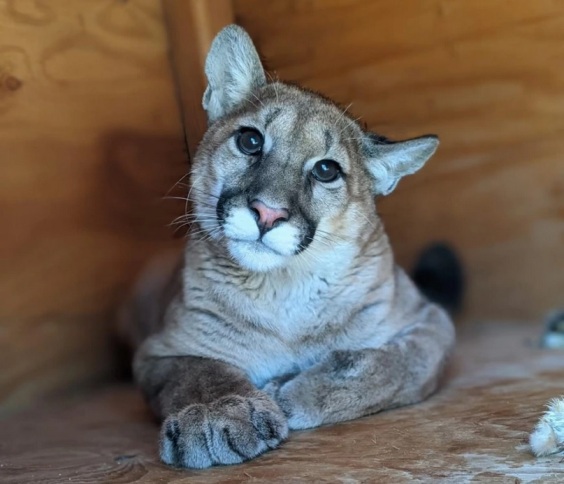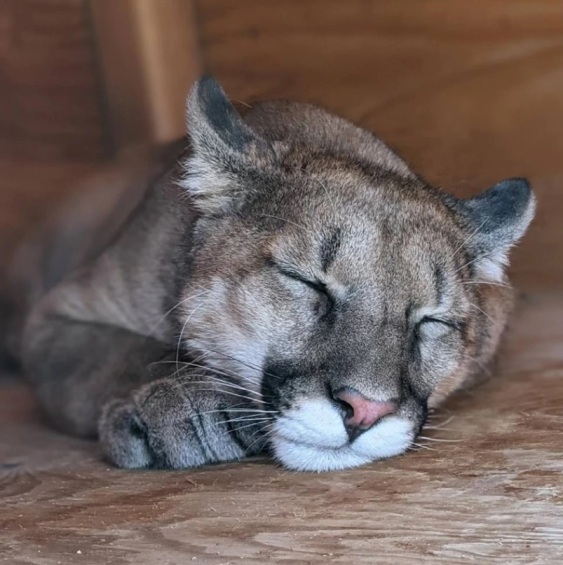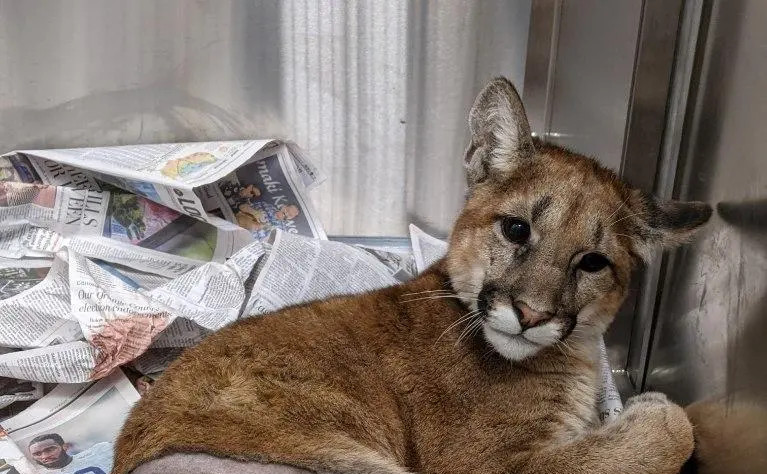Nicholas was just a cub and was following his mother across a busy toll road in Orange County, Calif., in 2020 when a driver hit them, killing his mother and leaving him with life-long disabilities.
Along with the trauma of watching his mother die, the little puma endured months of surgeries to repair his body. Since then, young Nicholas had been living in a sanctuary in northern California, but was about to find himself homeless when the sanctuary’s operators went bankrupt.
With just hours to go before that facility was closed, a sanctuary called Lions, Tigers & Bears of San Diego County swooped in and agreed to take the special-needs puma, who requires regular veterinary care.
“Nicholas has a head tilt and neurological issues, both conditions require ongoing veterinary care,” Lions Tigers & Bears founder Bobbi Brink told KTLA. “We’ve had a few animals with these issues, so our veterinary team is well-versed in providing the specialized care required for Nicholas, and we’re relieved to give him a permanent home with a den, a healthy diet, medical care and enrichment and toys.”
The handsome young puma is currently in quarantine, Brink said, and will be moved into his permanent habitat after 30 days.
Although California is part of their native range and home to a relatively stable population of mountain lions, the species is seriously threatened by habitat destruction, habitat fracturing and vehicle traffic. Some 70 pumas are killed each year on California’s highways, and experts say the survivors are stranded on isolated “islands” of habitat, separated from potential mates by deadly highways. Indeed, scientists who track native wildlife in California have noted signs of inbreeding among pumas, as the animals are cut off from other populations of their species.

The life of the much-celebrated, recently deceased mountain lion P-22 illustrates the problems faced by the unique cats.
P-22 became famous when he migrated from southern California to Los Angeles, crossing the state’s busiest and most dangerous highways to get there. He settled in LA’s Griffith Park, which straddles the hills with the famous Hollywood sign and the outdoor Greek Theatre.
Although he became a local icon, frequently making cameos on the doorbell camera systems of people living nearby and making his rounds through the park and surrounding neighborhoods, P-22’s range was only nine square miles — the smallest range ever recorded for an adult male mountain lion — and he did not have opportunities to mate and produce cubs, as his kingdom was cut off from areas where he might encounter female pumas.
One solution to the problem is to build land bridges connecting areas where mountain lions and other wildlife make their homes. In April of 2022, officials broke ground on the Wallis Annenberg Wildlife Crossing, which when complete will connect Agoura Hills to the nearby Santa Monica Mountains.
But such projects are wildly expensive and take years to complete. The Wallis Annenberg Wildlife Crossing has a $90 million price tag and won’t be finished until 2025. On the bright side, about two thirds of the cost has been covered by private donations, proving Californians and other wildlife lovers are invested in the survival of mountain lions, coyotes, deer and other fauna expected to make use of the bridge.
It’s also an encouraging sign indicating efforts to educate the public about local wildlife have been successful. Along with the other problems they face, pumas — also known as catamounts, cougars and dozens of other names — are often confused with African lions.

Because they’re large cats, they’re called lions and they resemble their African counterparts, many people assume mountain lions are dangerous. But not only are mountain lions (puma concolor) an entirely different species than African lions (panthera leo), they are not in the same category of felid.
Pumas are actually felines, meaning they’re more closely related to domestic cats, and like smaller cats they can purr but cannot roar. True big cats, like tigers, lions, jaguars and leopards, are members of the genus panthera and are capable of roaring, but not purring or meowing.
Perhaps most importantly, pumas are not aggressive toward humans. There are only 27 recorded deaths from encounters with mountain lions over the past century compared to more than 50,000 deaths from dogs, for example, and in almost every one of those cases the pumas were either cornered or their cubs were threatened.
Nicholas is not only a reminder that animal life is valuable, his circumstances also remind us that we’re going to have to find creative ways to ensure the survival of many species as humanity expands. The global population is expected to level off at about 11 billion and then slowly contract as third-world countries undergo the same lifestyle changes common to nations that have already made the transition to first world. But until then, it will take a massive and coordinated effort to ensure we don’t end up on a very lonely planet and likely endanger our own survival with the cascade failures that arise from extirpating entire species.
Follow Buddy the Cat on Facebook!


Thanks for this great article! I hope Nicholas will thrive in his new home.
LikeLiked by 1 person
I second that. He is so adorable!!
LikeLiked by 2 people
Indeed, he’s a very handsome puma. He can’t be released to the wild because of his injuries, so I’m glad he’s getting a comfortable home.
LikeLiked by 1 person
My heart goes out to this puma, and I hope he continues to thrive. Thank you for posting.
LikeLiked by 2 people
I spoke to the sanctuary’s founder today and will publish a follow-up article either tomorrow (Friday) or early next week.
LikeLiked by 1 person
Thank you, Big Buddy.
LikeLiked by 1 person
San Antonio, TX, doesn’t have pumas but does have a successful land bridge joining two parks separated by a divided highway. Much of the funding was private.
LikeLiked by 2 people
Thanks for mentioning that, Amanda. I just took a quick look, and the bridge has been used by bobcats, foxes, coyotes, deer, rabbits, raccoons and possums, according to images captured on the wildlife cameras set up on the bridge.
Stuff like this is crucial now and in the future, and hopefully we also learn to shape our communities so we’re not breaking up more habitats.
Likewise with light pollution, which is a whole other thing in terms of human impact on wildlife and on our own psychology in terms of forgetting the night sky and the stars.
LikeLiked by 1 person
Ugh, I didn’t read your reply before posting a question to Amanda …
LikeLiked by 1 person
All good! Here’s a good link with info on it:
https://www.philhardbergerpark.org/parknews/wildlife-documented-using-land-bridge
LikeLike
This link has more. I think this was the one I found earlier:
https://www.philhardbergerpark.org/parknews/more-wildlife-seen-on-the-land-bridge
LikeLike
That’s very interesting! What animals use the land bridge?
LikeLiked by 1 person
Thanks for this piece, Buddy, on one of your relatives. I genuinely hope he finally finds happiness in his new home. The pictures are a joy to look at and made my day
LikeLiked by 2 people
I spoke to the sanctuary’s founder today and will publish a follow-up story either tomorrow (Friday) or early next week.
LikeLike
I’m very glad to learn that Nicholas will be well taken care of!
LikeLiked by 1 person
I spoke to the sanctuary’s founder today and will have a follow up story either tomorrow (Friday) or early next week.
LikeLiked by 1 person
Mee-yow young Nicholas iss hansum an furry lucky hee was saved an is now saved again!!!
Peepell do not nose Pumass’ are reelated to us Buddy??? Man wee needss to eddycate Hu’manss’.
Thanx Big Buddy fore sharin Nicholas’ story an wee hope there iss a 2nd article once hee iss inn his new home an outta quaranteen!
Guud Luck Nicholas!
***purrss*** BellaDharma an 🙂 BellaSita Mum
LikeLiked by 2 people
I hope to have a follow-up in the near future. Looks like Nicholas has landed in a good home with caretakers who will make sure he has everything he needs.
LikeLiked by 1 person
I spoke with the sanctuary’s founder today and will have a follow up story either tomorrow or early next week.
LikeLiked by 2 people
HURRAH HURRAH!!!!!
LikeLiked by 1 person